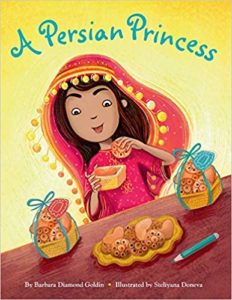A Persian Princess introduces early primary children to Persian traditions associated with the celebration of Purim. Barbara Diamond Goldin adeptly intertwines the special love associated with grandmothers with Persian words and customs. For example, Maman joon is used as an endearing term for grandmother throughout the story. Raya, the main character, and her grandmother, Maman joon model a positive intergenerational relationship.
Children familiar with the Jewish festival of Purim will be able to compare and contrast their family’s traditions with the ones included in the story. Readers who are unaware of the connection between Persia and the Biblical story of Esther can use the Note for Families as a reference.
As children’s awareness of holiday celebrations expand, they simultaneously become more tolerant of differences. While most Jewish children can recognize hamentashen, a triangular-shaped cookie that is eaten by Ashkenazic Jews during Purim, fewer will be aware of koloocheh, traditional Persian cookies. A Persian Princess helps children understand how Jewish customs and traditions may differ from region to region.
Younger siblings will be able to connect with the main character, Raya. Too young to participate in the annual Purim play, she feels left out. Her Maman joon fills in the gap by sharing special items from her earlier life in Hamadan, Iran and then offering to stage a home-based Purim play for the neighbors. Keep in mind that some boys may have difficulty relating to the emphasis placed on Raya’s princess attire.
Steliyana Doneva’s colorful illustrations can effectively be used as a picture walk through the story for younger children who do not have the attention span to listen to the complete text. Parents and educators can also ask younger children to identify objects in the engaging pictures.
By the end of the story, children will have been exposed to the key elements of the Purim story as well as ways that modern Jews celebrate the festival. The significance of the holiday is reinforced by the focus on foods, costumes, by retelling the Purim story and the giving of small gifts or mishloach manot.
Unfortunately, it was not possible to publish this story before Purim. While A Persian Princess is intended to be read in conjunction with the Jewish festival of Purim, the book can also be enjoyed throughout the year.
Interview
In my interview with the author, Barbara Diamond Goldin, you can read about her background as well as some helpful tips for aspiring writers.
Related Blogs
Jewish Children’s Favorites—11 Fall Picture Books
Jewish Picture Books for the High Holidays
6 Passover Picture Books—Seders and Rituals
DISCLOSURE
Prior to posting this blog, I was sent a complimentary copy of A Persian Princess.
BIO
Sandra Bornstein is the author of May This Be the Best Year of Your Life. Sandra’s memoir highlights her living and teaching adventure in Bangalore, India. She was a licensed Colorado teacher who taught K-12 students in the United States and abroad as well as college-level courses. In addition to reviewing books and interviewing authors, Sandra is a freelance lifestyle and travel writer. Many of Sandra’s stories appear on the For Readers page. Additional stories can be read on TheTravelingBornsteins website.

Connect with Sandra